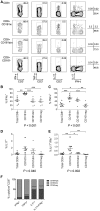Non-myeloablative autologous haematopoietic stem cell transplantation expands regulatory cells and depletes IL-17 producing mucosal-associated invariant T cells in multiple sclerosis
- PMID: 23864273
- PMCID: PMC3754461
- DOI: 10.1093/brain/awt182
Non-myeloablative autologous haematopoietic stem cell transplantation expands regulatory cells and depletes IL-17 producing mucosal-associated invariant T cells in multiple sclerosis
Abstract
Autologous haematopoietic stem cell transplantation has been tried as one experimental strategy for the treatment of patients with aggressive multiple sclerosis refractory to other immunotherapies. The procedure is aimed at ablating and repopulating the immune repertoire by sequentially mobilizing and harvesting haematopoietic stem cells, administering an immunosuppressive conditioning regimen, and re-infusing the autologous haematopoietic cell product. 'Non-myeloablative' conditioning regimens to achieve lymphocytic ablation without marrow suppression have been proposed to improve safety and tolerability. One trial with non-myeloablative autologous haematopoietic stem cell transplantation reported clinical improvement and inflammatory stabilization in treated patients with highly active multiple sclerosis. The aim of the present study was to understand the changes in the reconstituted immune repertoire bearing potential relevance to its mode of action. Peripheral blood was obtained from 12 patients with multiple sclerosis participating in the aforementioned trial and longitudinally followed for 2 years. We examined the phenotype and function of peripheral blood lymphocytes by cell surface or intracellular staining and multi-colour fluorescence activated cell sorting alone or in combination with proliferation assays. During immune reconstitution post-transplantation we observed significant though transient increases in the proportion of CD4+ FoxP3+ T cells and CD56(high) natural killer cell subsets, which are cell subsets associated with immunoregulatory function. CD8+ CD57+ cytotoxic T cells were persistently increased after therapy and were able to suppress CD4+ T cell proliferation with variable potency. In contrast, a CD161(high) proinflammatory CD8+ T cell subset was depleted at all time-points post-transplantation. Phenotypic characterization revealed that the CD161(high)CD8+ T cells were mucosal-associated invariant T cells, a novel cell population originating in the gut mucosa but expressing the central nervous system-homing receptor CCR6. Detection of mucosal-associated invariant T cells in post-mortem multiple sclerosis brain white matter active lesions confirmed their involvement in the disease pathology. Intracellular cytokine staining demonstrated interferon γ and interleukin 17 production and lack of interleukin 10 production, a pro-inflammatory profile. Mucosal-associated invariant T cell frequency did not change in patients treated with interferon β; and was more depleted after autologous haematopoietic stem cell transplantation than in patients who had received high-dose cyclophosphamide (n = 7) or alemtuzumab (n = 21) treatment alone, suggesting an additive or synergistic effect of the conditioning regime components. We propose that a favourably modified balance of regulatory and pro-inflammatory lymphocytes underlies the suppression of central nervous system inflammation in patients with multiple sclerosis following non-myeloablative autologous haematopoietic stem cell transplantation with a conditioning regimen consisting of cyclophosphamide and alemtuzumab.
Keywords: T cells; immune regulation; multiple sclerosis; proinflammatory cytokines; stem cells.
Figures






References
-
- Adams JC. Biotin amplification of biotin and horseradish peroxidase signals in histochemical stains. J Histochem Cytochem. 1992;40:101457–63. - PubMed
-
- Alexander T, Thiel A, Rosen O, Massenkeil G, Sattler A, Kohler S, et al. Depletion of autoreactive immunologic memory followed by autologous hematopoietic stem cell transplantation in patients with refractory SLE induces long-term remission through de novo generation of a juvenile and tolerant immune system. Blood. 2009;113:1214–23. - PubMed
-
- Annibali V, Ristori G, Angelini DF, Serafini B, Mechelli R, Cannoni S, et al. CD161(high)CD8+T cells bear pathogenetic potential in multiple sclerosis. Brain. 2011;134(Pt):2542–54. - PubMed
-
- Autran B, Leblond V, Sadat-Sowti B, Lefranc E, Got P, Sutton L, et al. A soluble factor released by CD8+CD57+ lymphocytes from bone marrow transplanted patients inhibits cell-mediated cytolysis. Blood. 1991;77:102237–41. - PubMed
-
- Berer K, Mues M, Koutrolos M, Rasbi ZA, Boziki M, Johner C, et al. Commensal microbiota and myelin autoantigen cooperate to trigger autoimmune demyelination. Nature. 2011;479:7374538–41. - PubMed
Publication types
MeSH terms
Substances
Grants and funding
LinkOut - more resources
Full Text Sources
Other Literature Sources
Medical
Research Materials

